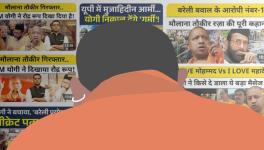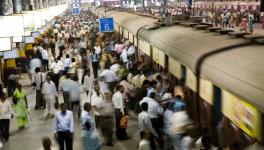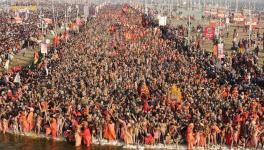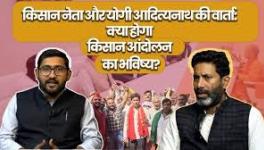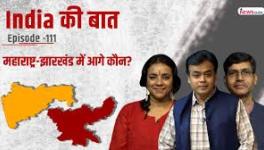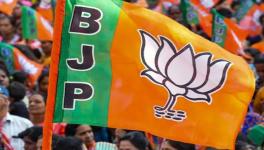Wooing Brahmins is as Good as Walking into Adityanath’s Trap
Representational use only.Image Courtesy: Outlook India
It seems surreal, in the backdrop of the horror wreaked by Covid-19, for the two principal Opposition parties in Uttar Pradesh—the Bahujan Samaj Party and the Samajwadi Party—to woo the Brahmins, arguably the most steadfast supporters of the ruling Bharatiya Janata Party, six months before the state elects its new Assembly.
Perhaps the political class feels the people will soon forget the tragedy of Covid-19 and, therefore, also Chief Minister Yogi Adityanath’s failure to combat the virus and provide succour to them. Inevitably then, Uttar Pradesh will return to thinking of caste—and voting along caste lines.
In this respect, Brahmins are considered no different from other castes. And they have reasons to feel alienated from Adityanath, who is said to have denied them plum posts in the administration. A Rajput, he is also accused of deploying power to give his caste brethren an edge in their political competition with Brahmins. The gunning down of gangster Vikas Dubey and Apple executive Vivek Tiwari is cited as evidence.
BSP leader Mayawati hopes to exploit their alienation by organising Brahmin conferences across the state, the first of which was held in Ayodhya last week. She has promised a “fair deal” to them, expedite the construction of the Ram temple, and build a statue of Lord Parshurama, whom the Brahmins revere as the sixth avatar of Vishnu, that is taller than the 108-foot one promised by SP leader Akhilesh Yadav. Following suit, Yadav has also asked his party’s Brahmin leaders to organise conferences to rally their community behind the SP.
Mayawati and Yadav seem to think the people of Uttar Pradesh, Brahmins included, are more inclined to remember injustices perceived to have been done in the name of caste than those universal—or cutting across the social divide—such as Adityanath’s failure to combat Covid-19, eloquently symbolised by the mass graves on the banks of the Ganga.
It also seems they do not think it is important to tell the people that Uttar Pradesh’s economy slowed under Adityanath. The Reserve Bank of India figures show that Uttar Pradesh’s Gross State Domestic Product, between 2011 and 2017, grew at an average annual rate of 6.9%. After Adityanath came to power in March 2019, the average growth rate declined to 5.6% between 2017 and 2020.
Uttar Pradesh’s expenditure in the social sector grew at an annual average rate of 14.3%, down by 2.6% than what the state had been spending between 2011 and 2017. Not for them the importance of debating whether the lower social spend could have been the reason why Uttar Pradesh keeled over against the Covid-19 onslaught. Nor for them any political value in pointing out that as of 7 February 2020, 33.94 lakh people were registered as unemployed, an incredible 58.43% jump over the 21.39 lakh unemployed registered until 30 June 2018.
It does seem from Mayawati’s rhetoric that she believes the right caste arithmetic plays a more decisive role in a government being voted out than depressing statistical details listed above. She has repeatedly harped on how the Dalit and Brahmin combination swept the BSP into power in 2007.
Mayawati’s analysis of her party’s 2007 victory is likely wrong.
The election survey data of the Centre for the Study of Developing Societies (CSDS) show that only 16% of Brahmins voted for the BSP in 2007. By contrast, 86% of Jatavs, 71% of Valmikis, 53% of Pasi, 58% of other Scheduled Castes, and 30% of other OBCs (Other Backward Classes excluding Yadavs and Kurmis/Koeris) voted for the BSP. It is because of them, not Brahmins, the BSP won 206 seats in the 403-seat Assembly.
The perception that the Brahmins played a decisive role in the BSP’s victory gained ground because 20 out of BSP’s 51 Brahmin candidates won. Their victory was driven by the votes of subaltern social groups than those of Brahmins.
In 2012, the BSP was voted out of power, even though the party bagged 19% of Brahmin votes, an increase of 3% over the 2007 figure. The BSP lost out because of the desertion of its Dalit voters in 2012—for instance, only 62% of Jatavs and 42% of Valmikis voted for the party.
Oliver Heath and Sanjay Kumar in their 2012 paper, Why did Dalits desert the Bahujan Samaj Party in Uttar Pradesh?, published in the Economic & Political Weekly, say, “If Dalits were unimpressed with Mayawati’s politics of symbols [erecting statues of Dalit icons, for instance], perhaps it is because they were hoping for more tangible benefits from having ‘their’ party in power.” They also showed that young, well-educated, wealthy Dalits are less likely to be swayed by the BSP’s politics of symbolism and political recognition than those who are older, less educated and poor.
The CSDS did not publish the voting pattern by caste for the 2017 Assembly elections. Although voters’ behaviour in Assembly and Lok Sabha elections differ, the BSP needs to worry that only 68% of Jatavs, the party’s mainstay, and 29% of other Scheduled Castes voted for it in the 2014 national elections. In 2019, 75% of Jatavs voted for the Mahagathbandhan, or the SP-BSP alliance, but only 42% of other Scheduled Castes did so. The rise in Jatav votes was largely because of their hopes that Mayawati could become prime minister in the event of a hung Lok Sabha. That hope and enthusiasm was not shared by other Dalit subgroups.
The BSP’s stock among the Brahmins has continued to dip—only 5% of them voted for the BSP in 2014, and 6% of them did for the SP-BSP alliance in 2019. The BJP, by contrast, has been the principal repository of Brahmin votes. The party bagged 44% of Brahmin votes in 2007, 72% in the 2014 Lok Sabha elections, and 82% in 2019.
It is unlikely that the BSP’s high-voltage Brahmin conferences can enable the party to grab a large chunk of this influential caste’s votes. As Heath and Kumar say in another context, “Socialisation theories of partisan support suggest that loyalty towards a political party strengthens over time through the constant repetition of voting” for it.
In other words, the Brahmins are unlikely to desert the BJP in droves. Even in 2007, when the BSP organised Brahmin sammelans, 44% of Brahmins voted for the BJP, which was not even expected to capture power.
Caste does play a vital role in electoral politics. But it is not the only determinant of the voter’s behaviour. In 2012, the SP bagged just 66% of Yadav votes, the party’s mainstay, down from the 72% it had mustered in 2007. Still, it won 224 seats in 2012 not because it did better among Yadavs, but because, as Heath and Kumar point out, it managed to “attract voters from various other communities.”
The SP’s victory in 2012 does show that there exists ample room for political parties to opt for cross-caste/class mobilisation. The SP, despite competing for Brahmin votes on the issue of caste pride and hurt, appears better placed to become a magnate for other castes even today. For instance, the SP can hope to harness the ongoing protest of farmers of west Uttar Pradesh to its advantage, not least because of its likely alliance with the Rashtriya Lok Dal, which represents peasant/Jat interests.
Indeed, for the Opposition to woo the Brahmins is as good as falling into Adityanath’s trap. The sharper the focus on the politics of identity, the greater the chances of Adityanath to evade the popular examination of his record of misgovernance. Such a focus will also create a context for Adityanath and the BJP to turn the 2022 Assembly battle into one between the Hindus and Muslims.
Journalist DK Singh, in a piece on the Print website, explains why Adityanath seems more inclined to mentioning in his public interventions All India Majlis-e-Ittehadul Muslimeen leader Asaduddin Owaisi than Mayawati or Yadav. For instance, when Owaisi announced that the AIMIM would contest 100 seats in Uttar Pradesh, Adityanath reacted: “Owaisiji is a big national leader. He goes to different parts of the country for campaigning and has his own credibility among people. If he has challenged the BJP, then BJP’s workers accept Asaduddin Owaisi’s challenge.”
Such statements are not likely to have an echo when governance becomes the pressing electoral issue—and cross caste/class appeal becomes the dominant mode of mobilisation. Such statements from Adityanath will seem nothing more than a ruse to ensure the Assembly elections do not turn into a referendum on his governance—or the lack of it.
The author is an independent journalist. The views are personal.
Get the latest reports & analysis with people's perspective on Protests, movements & deep analytical videos, discussions of the current affairs in your Telegram app. Subscribe to NewsClick's Telegram channel & get Real-Time updates on stories, as they get published on our website.









